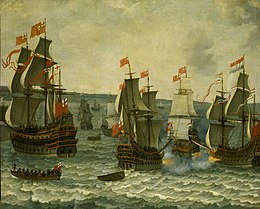Maarten Tromp
Born in Brielle in the Netherlands, Tromp was the oldest son of Harpert Maertensz, a naval officer and captain of the frigate Olifantstromp ("Elephant Trunk").[1][2][3][4] In 1610, after his father's discharge because of a navy reorganization, the Tromps were on their way to Guinea on their merchantman when they were attacked by a squadron of seven ships under command of the English pirate Peter Easton.[8] Tromp joined the Dutch navy as a lieutenant in July 1622, entering service with the Admiralty of the Maze based in Rotterdam, serving aboard the Bruynvisch.[2] On 7 May 1624, he married Dignom Cornelisdochter de Haes, the daughter of a merchant; in the same year he became captain of the St. Antonius, a fast sailing dispatch and escort yacht.[4] In 1637 Tromp re-enlisted in the Dutch navy and was promoted from captain to Lieutenant-Admiral of Holland and West Frisia, under the Stadtholder, Frederick Henry, Prince of Orange.[13] Tromp accepted but under the conditions that afforded him greater authority than was allowed for the navy’s previous commanders, remembering how badly the fleet had been neglected by them under van Dorp.[14] Although formally ranking under the Admiral-General Frederick Henry of Orange, he was the de facto supreme commander of the Dutch fleet, as the stadtholders never fought at sea.[15] Tromp out-maneuvered Oquendo's fleet which was bound for Flanders but was forced to retreat to England at the Downs, behind the sandbanks of the Kentish coast, where they remained trapped, while a prolonged debate preceding the Wars of the Three Kingdoms continued in London.[17] During the Fight in the Channel, a preliminary action to the Downs, Tromp was the first fleet commander known for the deliberate use of line of battle tactics,[15] marking the end of Spanish naval power.[20] In 1643 the deputy of parliament in Holland made a loud protest in the General Assembly against the Prince of Orange for his orders to Tromp to allow two of the frigates bought by English royalists in Dunkirk, for his use and command.Opposed to her returning to England the Parliamentarian squadron under William Batten threatened to attack the Queen's convoy when it landed at Bridlington but was thwarted by Tromp to withdraw.Near the mouth of the river he came upon an English squadron, commanded by Sir George Ayscough, who had the advantage of the weather gage, thus preventing Tromp from engaging effectively.Subsequently, Tromp decided to return to the Netherland coast, which was a decision that was not at all well received by the Dutch government, resulting in his removal from command, with Admiral de Ruyter taking his place.[35][36] Subsequent to de With's defeat, Tromp was reinstated as commander, on 8 May, which proved to be a big boost for Dutch navy morale, which was the highest it had been since he was dismissed months before in July.A great convoy of 300 merchant ships was ready to leave the Netherlands headed for the Bay of Biscay, accompanied by a large fleet of 73 warships and a small number of fireships which were sent in escort to protect it.The re was much hand-to-hand fighting that lasted until about 5:00 pm with the advance of nightfall, with the Dutch fleet prevailing, taking several British prizes, while Blake retreated to the mouth of the Thames.

Maarten van Tromp
by Jan Lievens
by Jan Lievens


Battle of Scheveningen
,
Tromp's final battle
Tromp's final battle

(Diameter: 7.18 cm / 2.82 in) [ 46 ]
Maarten Tromp (rower)Jan LievensBrielleDutch RepublicBattle of ScheveningenOude KerkEighty Years' WarBattle of GibraltarAction of 18 February 1639Fight in the ChannelBattle of the DownsSiege of DunkirkFirst Anglo-Dutch WarBattle of DoverBattle of DungenessBattle of PortlandBattle of the Gabbardarmy generaladmiralDutch navyBarbary corsairsSeveral ships of the Royal Netherlands NavyCornelisSt. Catherine's CathedralRotterdamAdmiralty of RotterdamMooy LambertJacob van HeemskerckDunkirkEast IndiesGuineaPeter EastonBarbaryBey of TunisJohn WardPiet Pieterszoon HeinlieutenantAdmiralty of the MazeOstendstadtholderFrederick HenryDunkirkerscommandeurdeaconschepenLieutenant-AdmiralFrederick Henry, Prince of OrangeWitte de WithAdmiral-GeneralFrederick Henry of OrangestadtholdersAemiliathe DownsKentish coastWars of the Three KingdomsCalaisCardinal RichelieuCharles Iline of battleBattle of Kentish KnockJacob van Wassenaer ObdamQueen Henrietta MariaKing Charles IWilliam BattenBridlingtonAbraham WillaertsDungenessPortlandthe GabbardScheveningenOliver CromwellRump Parliamentissued an ordinanceNavigation ActsNieuportMeuse RiverRobert BlakeFairlightBrederodeThames RiverGeorge Ayscoughweather gageAdmiral de RuyterBattle of the Kentish KnockResolutionSovereignBaltic SeaNewcastleBay of BiscayfireshipsJan EvertsenTriumphGregorian calendarSuffolkVrijheidGeorge MonckRichard DeaneWilliam PennEgbert Bartholomeusz KortenaerCommonwealth of EnglandStuartTreaty of WestminsterCornelis Maartenszoon TrompSecond Anglo-Dutch War(A–L)(M–Z)HMS Sovereign of the SeasEnglish ship Prince Royal (1610Andrew LambertClowes, William Laird, SirDixon, William HepworthGardiner, Samuel RawsonHyde, Edward, Earl of ClarendonIsrael, JonathanLambert, Andrew D.Warnsinck, JCM